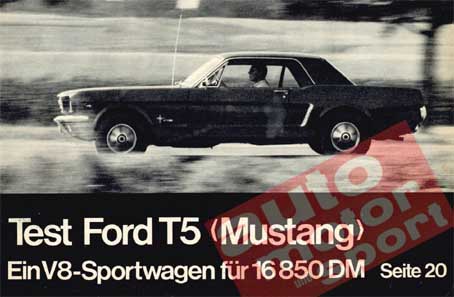 |
translated by Wolfgang Kohrn, 4.April 2000, last update 08.11.02
 |
TEST FORD T 5 (MUSTANG)
A big advertising campaign accompanied the launch of the new Mustang in the spring of 1964 by Ford USA. The success was overwhelming - within 3 month more than 80.000 cars were sold, production (1200 units a day) was soon up to the 100.000 maximum.
Alas the formula the car was built after, is not quite new. Ford used the same concept for the Thunderbird. The Mustang is as well a sporty coupe with 4 seats and corresponds in its basic technical construction to the typical American regular sedans. But while the Thunderbird is more up to the size of the bigger Ford and Mercury models, the Mustang rather fits into the size of a Falcon, fitting into the compact class of the Ford family. Thus it is much lighter and cheaper than the Thunderbird. Apparently US buyers forgot about their resentments towards compact cars in the case of a sporty coupe like the Mustang. Maybe because a Ferrari is also not a big car in size and they consider the Mustang as functional and sort of European style. Ford apparently has truly recognized and met the taste of the buyers. - In contrary to the last projects like the Edsel and Cardinal. The Mustang is selling like hotcakes.
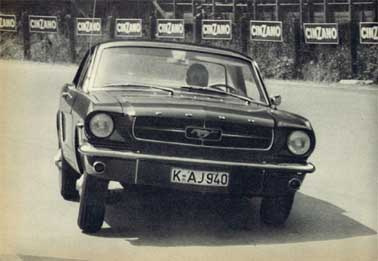 |
Advantages - Strong and torquy V8 - Relative low fuel consumption - Large-size interieur - good for 4 persons
|
The Mustang launch is not limited to America, indeed as Ford says, it is planned worldwide. It started with the publicity tour of the Mustang I, the small sportscar, that was built according to the ideals of a European race car and included the V4-engine from the German Ford 12M. The engine was located just in front of the rear axle (see Auto, Motor & Sport 22/1963). No insider however, believed that this car would ever be built for the public, because it was way too expensive in its basic construction with the tube-style frame and the Lotus-derived suspension. We are not talking about the missing roof or the ultra-small front glass. Indeed it was only a funny teaser and has successfully fulfilled its role. Following the debut in Europe this time a small group of the real Mustangs came to Europe and they were staged by Ford very professionally so that almost each car enthusiast in Europe knows about the Mustang - despite the fact that not even 10 cars came over the ocean.
In Germany a small problem had to be managed: The companies Kreidler and Krupp, that had secured their copyrights for the name "Mustang" for small motorbikes and bigger trucks. They protested against the usage of the name by Ford. So the stylists from Cologne went to work and produced some small metal emblems (original text says letters) with T 5, that were attached to the US cars. However, the running horse in the grille and at the fenders made it quite clear to the spectator, what this car was named originally.
A successful formula
The big success of the Mustang in America is based for sure on the bodyline. Southern German Ford dealers have already sold a respectable number of cars to American customers, while the German potential customers are still waiting. In the USA people are not used to think a lot about technical questions, if the car body looks attractive, except for the real sportscar enthusiasts. They are still critical towards the Mustang, when comparing it to other European sportscars. "It‘s not the car we hoped it would be", has been written by "Road & Track" as a headline, "but it is a step in the right direction". But R&T also admits, that the body style is the "most distinctive feature" of this car.
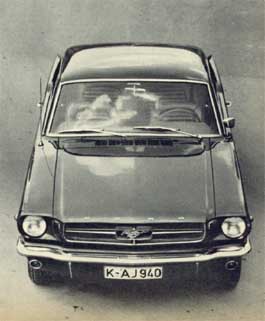 |
The impression of "Elegance" is imposed by the backward moved roof, a formula that is proven successful in the past. Thus the car offers a long hood and a short rear - both components for any sportscar. The wheelbase of 2,74m, that is somewhat like a bigger 5-seater sedan, is not used completely. But the rear seats offer full-size comfort, that we can talk of a real 4-seater. The roofline offers enough headroom for the rear passengers. The large doors allow an easier entry to the rear seats as in most of our 2-door sedans. Seat depth and knee room are not as good, but still can be used by normal people for longer trips. Even the trunk offers so much space, that a family can make use of it during their holidays. Ford has apparently thought about the needs of a sporty yet daily driver for the day-to-day duties. According to European measuring the car is not small, in fact it is 10cm longer and 3cm wider than a Opel Rekord is.
While we had different opinions about the relatively high grille and the fake rear side air intakes before the rear wheels, the total concept clearly indicates, that the designer of this car do very well know their business. The Mustang is available in several body forms - as a Coupe, which roof can be covered with vynil, a convertible with manual or power top. The convertible with a self-carrying construction is enhanced with a very strong platform. The backbone is the driveshaft tunnel. In both versions the side windows can be moved completely down, whereas we experienced very high resistance in our test car. The small vent window frame is a little bit dangerous with its sharp end when the door is open.
Like many US-cars the technical "options" are limited to a variety of engine and suspension options. Real sophisticated details are completely missing and that is probably what American sportscar enthusiasts don't like with the Mustang. GM equipped the StingRay with an independent rear suspension like in Europe. The Mustang however, is using the well-known leaf-spring based fixed rear axle. Unfortunately the impressive construction of the Mustang 1 prototype had not made its way into the serial production, although it shows that Ford can play this piano as well. But if it comes to big business, it pays off to forget about the finer things of car craft.
| The T 5 and its competitors | Ford T 5 Coupe |
Fiat 2300 S Coupe |
MB 230 SL Roadster |
Porsche 901 Coupe |
| engine size ccm | 4738 |
2279 |
2306 |
1991 |
| HP(DIN) at Rpm | 190/4400 |
136/5600/ |
150/5500 |
130/6200 |
| Torque mkg at Rpm | 41,512800 |
18,2/4000/ |
20/4200 |
16,5/4600 |
| Weight kg | 1335 |
1324 |
1395 |
approx. 1000 |
| Price DM | 17.470,-/3) |
20.900,- |
20.600,- |
23.700,- |
| Acceleration in seconds | ||||
| 0 to 60 km/h | 4,2 |
4,7 |
4,4 |
- |
| 0 to 80 km/h | 6,5 |
7,5 |
6,6 |
5,9 |
| 0 to 100 km/h | 9,2 |
10,8 |
9,7 |
8,7 |
| 0 to 120 km/h | 13,4 |
15,1 |
13,6 |
12,5 |
| 0 to 140 km/h | 17,8 |
21,1 |
19,2 |
19,8 |
| 0 to 160 km/h | 23,8 |
30,9 |
26,8 |
25,9 |
| 1 km, standing launch | 29,6 |
32,0 |
29,7 |
29,5 |
| Top speed km/h | 194 |
195 |
202 |
210 |
| 1) Factory information; 2) Cuna; 3) incl. V8-engine and 4-speed | ||||
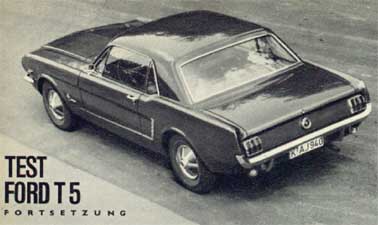 |
Just one feature is reminding us of contintental sportscars - front disc brakes. They could not be delivered until now, but will be available with the 65 model. From autumn forward other US-car manufacturers will offer front disc brakes as well. Aside from this option HD drum brakes with or without power assist, a more direct steering ratio plus power steering, HD springs and absorbers, automatic or 4-speed transmission (standard 3-speed), special tires, many exterior options and last not least various engines are available. These include the standard Six (105 DIN HP), two 289 V8 with 2V (175 DIN HP) and 4V (190DIN HP).
Driving experience: questionnable!
The group of Mustangs imported for press purposes included Coupes and convertibles with different equipment. We drove the sportier version, a coupe with a 289/4V and 4-speed manual transmission. It is very typical for American "uncareness" that they marry such a big engine with the same suspension, those usually only takes the 105 DIN HP standard engine. Top speed is published by Ford at 175km/h, but we were able to get the car up to 194km/h. Based on the 190DIN HP we were not very much surprised, but don't ask us about safety at this speed. The brakes were no way of sufficient to get the car down to zero speed and with some uneven spots on the Autobahn, we needed 2 lanes, to keep the car on the road. With other words: the car was really a looser, if measured against other cars with the same top speed. The only competitive feature of the engine was the impressive acceleration. Anyway, braking into winding curves was a definitely a no-go, because the brakes completely failed and needed hours to recover from fading. Driving curves quick was almost impossible despite the new Dunlop SP tires, that were mounted in Cologne because the car stomped and lifted like a steamer on the ocean. On bad roads there was not even a chance to use the power of the engine, neither straight nor windy - the rear tires were too often off the road. Our judgment upon our first impressions: A mass production box - put together without any further thought, but with a superb torquy and powerful engine.
We would not have written a test-report here, if Ford had not calmed our criticism, that in this form no Mustang would be delivered to Europe. They told us that the 65 model would be the first model to be imported with a lot of improvements. In general the so-called heavy-duty-version will be the only one available in Europe. Features of this will be improved brakes, much stronger springs and more adequate shock absorbers. None of these was yet available, so we had to be content, with what we had. Without doubt, these improvements will enhance the driving safety of the T 5 considerable. We got a teaser, when after 1000 miles, although we had not outperformed the brakes, they totally failed. The Stuttgarter Schwabengarage replaced them - and as they had yet no Mustang parts available, they took parts from a Fairlane. These bigger brakes, were much better and were even good for Swiss Mountain roads, but not as good as disk brakes would be.
The usual lock-up of the rear tires during extreme braking was not experienced in normal town cruising, maybe because we had bigger loads in the trunk. The very weak and badly absorbed spring equipment was experienced also in normal driving. The car very often moved around its own axis, the rear axle had very often contact with the rubber bump stops. We believe, that not only the European customers, but also the American Mustang-drivers would be much better served with a HD suspension, because the current version is really dangerous rather than convenient. Mounting stronger springs and shocks will enhance the straight driving on bad roads as well, because the "co-steering-effect" of the rear axle will be much less.
Another step for improvement will be the disk brakes, that will be available as an option. Curious enough they will be not available with a power option, so the necessary foot pressure will be probably very high. The drum brakes that we had in our test car, had no power assistance, but they have apparently a very strong self-assistance, thus needing only minor foot pressure.
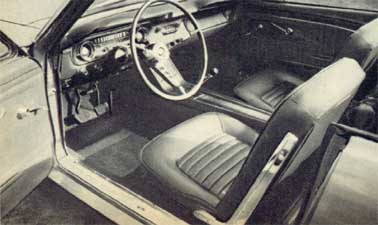 |
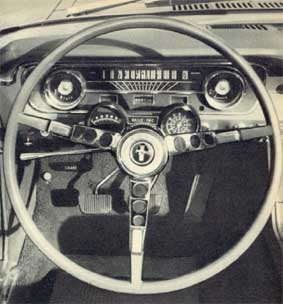 |
The steering did not call for assistance (although it is available), it was was very easy to control, but had a very indirect feel. A quicker ratio is available, that probably needs power assistance. With the standard steering the T 5 is an easy to steer car, but not very handy. We were surprised about the very good gear changing of the 4-speed-transmission. The short lever was easy and safe to shift, the synchronizing was perfect. Usually transmissions, that have to deal with lots of power, are not so easy to operate. A good feature was the locking mechanism for the rear gear. Unfortunately it is a little bit sharp and you might cut yourself.
The engine is very powerfull and stops any criticism - only it outperforms the chassis a lot. With such an engine in a very light car you can manage a lot. Remarkbly the engine did not use too much fuel. Driven between 2000 and 4000 rpm we noticed a consumption of 13 to 18 Liter/100km, meaning not much more than with European six-cylinder sports cars. Here the Mustang sets itself apart from the Thunderbird, where 20 to 30 liters/100km were a normal value. This prohibits the Thunderbird for Europe. Talking about reliability, there will be no problem for sure, if you think of the low rpms. The acceleration is already very impressive under 4000 rpm, so you rarely want to use the maximum power band up to 5000 rpm. Above this red line the engine quickly looses power.
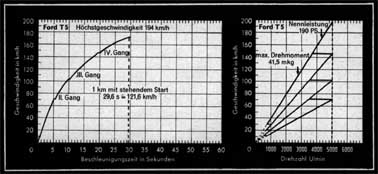 |
Back to the acceleration: you can outperform most European sportscars with the T 5. But naturally the Porsche 911 and the Mercedes 230SL, that basically correspond to the powerband of the T 5, are much quicker on windy roads. But as Ford had already proven with the Falcon, what you can do with such mass production suspensions, if you want to squeeze it.
Maybe the T5 will be available in Europe with the 175DIN HP 2V version, not with the 4V 190 HP. The current listed option price of DM 600,-- seems to be for the lower number V8 (Ford could not clarify it). We would like to say, that under normal conditions, nobody will ever complain about the 175 HP, because we could hardly use the 190 HP. The impressive power reserves during overtaking - one of the biggest plus of the T5 - will not encounter any problems with the 2V.
We had no chance to test the Six. We just got aware of the judgement of our austrian colleague Hans Patleich, who drove this one and was very disappointed, then he left the car very quickly, because "neither acceleration nor roadworthy driving nor a brake" was there. It corresponds for sure to our mid-size compact cars, but does not correspondend witht the image of a sporty car. As the 8-cylinder car it is very cheap, there is no reason to not decide for this powerful engine. However, you might think about an automatic transmission. The V8 takes the slippage very easy and the going with the automatic is really worth the amount of this option. It is not without reason that even European sports car manufacturer foresee a great future for the automatic transmission. Here it is up to you, wether you are a maual or an automatic guy.
As soon as the T5 will be available in the 65 version, we will test it again. No doubt, the current cars cannot be recommended, no doubt as well, that the planned improvements will move the image to the positive side. With an V8 engine, 4-speed and disk brakes the T5 costs DM 17660,--. The prices are now the "dealer recommended" prices type, but will probably not much change for the 65. With this the T5 is very cheap, if you consider the power and that it is a true sportscar, not a modified sedan. The "features" of mass production cannot be neglected with the T5, but they show up not only in the "cheap" workmanship, but also in the overall quality. Never has a sports car been produced in such a big numbers, but Ford has apparently a good calculator. Ford has also cared for a good preparation- the company has gained a lot of reputation with its recent racing success. That will probably cause a lot of headaches for European sports cars manufacturers.
Author: Reinhard Seiffert, Auto,Motor und Sport
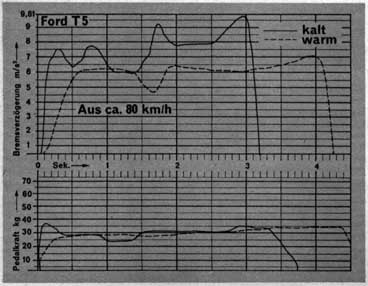 |
This brake testing (see diagramm) was not done with the standard brakes, but with the Fairlane front drum brakes. Efficiency and repeated usage of the brakes was much better than with the standard drums. Anyway they still did not meet state-of-the art requirements for such a powerful car. The rear wheels tend to lock up very early.
Technical Datas and Test results (not translated)
FORD T 5 (MUSTANG) COUPE
ENGINE
Achtzylinder - Viertakt - V - Motor, Bohrung X Hub 101,6 X 72,9 mm, Hubraum 4738 ccm,
Verdichtung 9:1, Leistung 190 PS (DIN) bei 4400 U/min, spezifische Leistung 40,1 PS/Liter
(wahlweise 175 PS-V8-Motor oder 3,3 Liter Sechszylinder-Reihenmotor mit 105 PS), maximales
Drehmoment 41,5 mkg (DIN) bei 2800 U/min, mittlere Kolbengeschwindigkeit bei Nenndrehzahl
(4400 U/min) 10,7 m/s, bei 100 km/h im vierten Gang (2520 U/min) ca. 6,1 m/s, zentrale
Nockenwelle, über Stoßstangen und Kipphebel betätigte hängende Ventile, hydraulische
Stößel, Wasserkühlung mit Pumpe und Thermostat, Druckumlaufschmierung,
Hauptstrom-Ölfilter, Ölinhalt 4,8 Liter, 1 Vierfachvergaser, 60 Liter-Tank im Heck,
Batterie 12 Volt 55 Ah, Lichtmaschine 450 Watt.
TRANSMISSION
Einscheiben-Trockenkupplung, vollsynchronisiertes Vierganggetriebe mit Mittelschaltung
(wahlweise Dreiganggetriebe oder automatisches Getriebe), Übersetzungen (in Klammern
Gesamtübersetzungen): 1. 2,78 (8,35), 11. 1,93 (5,78), 111. 1,36 (4,08), IV. 1,0 (3,o),
R. 2,78 (8,35), Hinterachse 3,0.
SUSPENSION
Plattformrahmen mit Längsträgern verschweißt, mittragende Ganzstahlkarosserie, vorn
Einzelradaufhängung an Querlenkern, Schraubenfedern, Querstabilisator, hinten Starrachse
an Blattfedern, vorn und hinten Teleskopstoßdämpfer, Kugelumlauflenkung, Übersetzung
27:1, auf Wunsch 22:1, hydraulische Fußbremse, Trommelbremsen, auf Wunsch
Bremsverstärker oder vordere Scheibenbremsen, Stockhandbremse mechanisch auf Hinterräder
wirkend, Reifen Dunlop 185-14 Nylon SP (Normalausstattung für Sechszylinder 6.50-13, für
V8 7.00-13), Luftdruck 2,6/2,4 atü.
DIMENSIONS
Radstand 2743 mm, Spur 1422/1422 mm, Außenmaße 4613 X 1732 X 1298 mm, Innenbreite vorn
1380 mm, hinten 1340 mm, Innenhöhe über Sitzhinterkante vorn 920 mm, hinten 880 mm,
Sitztiefe vorn 460 mm, hinten 380 mm, Knieraum hinten 160 bis 290 mm (je nach Stellung der
Vordersitze), Wendekreis rechts 12,6 m, links 13 m, 5 Lenkradumdrehungen von Anschlag zu
Anschlag.
WEIGHTS
Eigengewicht vollgetankt 1335 kg (davon Vorderachse 755 kg, Hinterachse 580 kg,
Gewichtsverteilung 56,6:43,4), zulässiges Gesamtgewicht 1800 kg, Zuladung 465 kg,
Personen-Indexzahl 5,5, Leistungsgewicht vollgetankt 7 kg/PS, mit 340 kg Belastung (vier
Personen mit Gepäck) 8,8 kg/PS.
TEST RESULTS
gear range
I. gear up to 71 km/h
II. gear 12 to 103 km/h
III. gear 20 to 146 km/h
IV. gear from 30 km/h
Top Speed 194 km/h
Acceleration see comparision table
Fuel Consumption
(Superbenzin)
Autobahn Schnitt 150 km/h 18,9 Liter/100 km, Autobahn Schnitt 110 km/h 13,1 Liter/100 km
Landstraße Schnitt 70 km/h 15,2 Liter/100 km
Kurzstreckenverkehr 17,4Liter/100km
Testverbrauch 16,4 Liter/100 km
INTERIOR NOISE
(Gemessen nach ISO-Kurve A)
Leerlauf im Stand 51 Phon
Bei 50 km/h 66 Phon
Bei 80 km/h 72 Phon
Bei 100 km/h 74 Phon
Bei 120 km/h 79 Phon
Bei 160 km/h 83 Phon
PRICES (dealer recommendation)
Coupé zweitürig, Standard mit
Sechszylindermotor . . . DM16.250,-
Cabriolet zweitürig, Standard
mit Sechszylindermotor . . DM 17 750,-
Aufpreis für V8-Motor . . . DM 600,-
Aufpreis für Vierganggetriebe . DM 620,-
Aufpreis für automatisches Getriebe (bei Sechszylinder-Motor) . . . . . . . . DM 1 000,-
Aufpreis für automatisches Getriebe (bei V8-Motor) . . . DM 1 060,-
Bremskraftverstärker (bei Trommelbremsen) . . . . DM 230,-
Aufpreis für vordere Scheibenbremsen . . . . . . . DM 190,-
Aufpreis für Servolenkung . DM 460,-
Aufpreis für Klimaanlage . DM 1 650,-
Prices for Austria and Switzerland not fixed yet.
SERVICE
Ölwechsel alle 10 000 km, Schmierdienst alle 50000 km, Inspektion alle 10000 km oder
zweimal im Jahr.